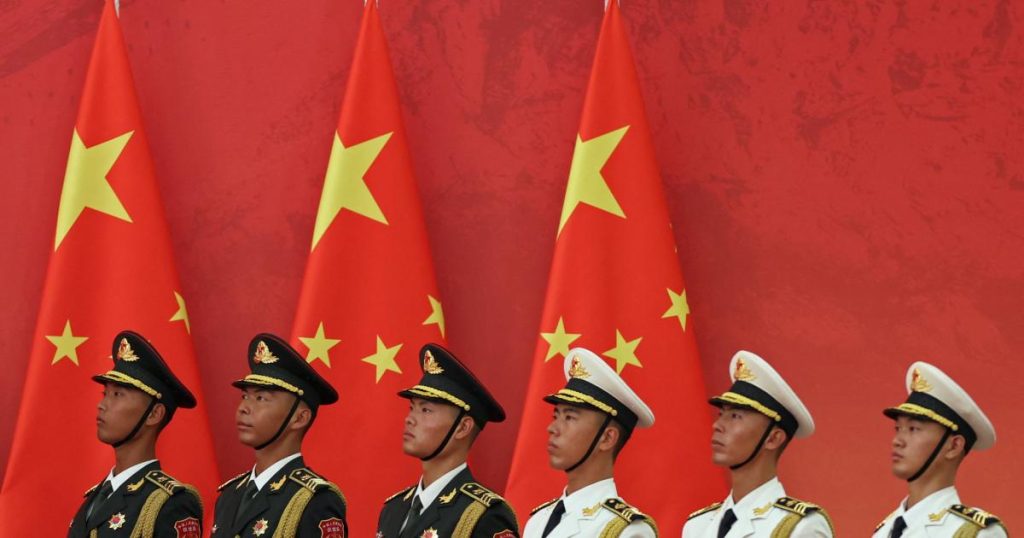In the months since Donald Trump won the U.S. presidential election in November, policymakers in Beijing have been looking to the next four years of U.S.-Chinese relations with trepidation. Beijing has been expecting the Trump administration to pursue tough policies toward China, potentially escalating the two countries’ trade war, tech war, and confrontation over Taiwan. The prevailing wisdom is that China must prepare for storms ahead in its dealings with the United States.
Trump’s imposition of 10 percent tariffs on all Chinese goods this week seemed to justify those worries. China retaliated swiftly, announcing its own tariffs on certain U.S. goods, as well as restrictions on exports of critical minerals and an antimonopoly investigation into the U.S.-based company Google. But even though Beijing has such tools at its disposal, its ability to outmaneuver Washington in a tit-for-tat exchange is limited by the United States’ relative power and large trade deficit with China. Chinese policymakers, aware of the problem, have been planning more than trade war tactics. Since Trump’s first term, they have been adapting their approach to the United States, and they have spent the past three months further developing their strategy to anticipate, counter, and minimize the damage of Trump’s volatile policymaking. As a result of that planning, a broad effort to shore up China’s domestic economy and foreign relations has been quietly underway.
China’s preparations roughly mirror the Biden administration’s China strategy of “invest, align, and compete,” which involved investing in U.S. strength, aligning with partners, and competing where necessary. Beijing’s playbook for riding out the Trump years, meanwhile, focuses on making the domestic economy more resilient, reconciling with key neighbors, and deepening relationships in the global South. Trump may well be able to score some short-term victories, but Beijing’s plans look beyond him. Chinese leaders remain convinced of the country’s historic destiny to rise and displace the United States as the world’s preeminent power. They think that Trump’s policies will undermine U.S. power and reduce U.S. global standing in the long run. And when that happens, China wants to be ready to take advantage.
REFORM MOVEMENT
Fortifying the home front has been a key element of Beijing’s strategy. Expecting that Trump’s presidency will bring volatility in the form of trade, sanctions, and export controls, China has been introducing stimulus measures to boost the real economy and strengthen domestic consumption. On November 8, three days after the U.S. election, Beijing announced a program to distribute $1.4 trillion to reduce local government debts over two years. The International Monetary Fund estimates that Chinese local government debts total around $9 trillion; addressing the problem represents a major push by the central government to stabilize the economy and instill more confidence in the Chinese market. A month later, on December 9, Beijing pledged “more active fiscal policies and moderately loose monetary policies,” which in practice entail more government spending, budgetary expansion, and lower interest rates. This marks a shift away from the belt-tightening policies that have been in place since 2010 and toward economic stimulus. In mid-December, China’s Central Economic Work Conference, a key government meeting that determines the economic policy for the next year, reiterated those promises. Its recommendations included more government spending, interest rate cuts, and other policies meant to generate growth.
Beijing has reason to introduce such measures regardless of Trump. The economic slowdown in recent years and the tepid results of the government’s stimulus efforts so far warrant more substantial intervention. But apprehension about rising tensions with the United States undoubtedly spurred policymakers on. In its December announcement, the Central Economic Work Conference cited the “deepening negative impact from the changed external environment” as the motivation for its updated fiscal policies. The most significant change to China’s external environment is the outcome of the U.S. election.
Trump’s imposition of tariffs seemed to justify China’s worries.
Beijing’s push for reform is not just about fixing domestic economic problems, either. It is also an effort to open up new opportunities for international trade. In discussions with members of the U.S. policy community after the November election, Chinese interlocutors expressed interest in fulfilling the Phase One trade deal signed by Beijing and Washington in January 2020, which would see China purchase $200 billion worth of U.S. products. They even brought up the possibility of beginning Phase Two negotiations, which would focus on structural reform, including measures addressing the relationship between the Chinese government and state-owned enterprises. Given Beijing’s sensitivity regarding such topics, progress on these negotiations has long seemed a remote prospect. But with an economic slowdown at home and the trade war with the United States escalating, China is feeling more pressure.
China is also looking to diversify its trade options. Over the past few months, statements from the Chinese foreign and commerce ministries have referred repeatedly to China’s effort to join the Comprehensive and Progressive Agreement for Trans-Pacific Partnership, the 12-member trade agreement that succeeded the Trans-Pacific Partnership, which stalled in 2017 after the United States withdrew. Members of the CPTPP must meet stringent entry requirements, which in China’s case would require serious structural reform. Beijing recognizes the value of multilateral trade mechanisms: China’s accession into the World Trade Organization in 2001 was probably the single largest factor in China’s economic rise. As countries move away from the WTO and toward alternative arrangements such as the CPTPP, Beijing wants to make sure it is not left out. With Trump in power, inclusion is all the more vital as China seeks to compensate for lost access to U.S. markets.
MENDING FENCES
China’s preparations for Trump have also involved a diplomatic push. In anticipation of heightened tension in the Indo-Pacific, China has tried to tie up loose ends with India and Japan, two neighbors with whom China had turbulent relationships for the past several years. Stability in China’s immediate neighborhood will minimize distractions for Beijing and could undermine U.S. efforts to push its partners to pressure China. Improving ties with both Japan and Australia, too, is a way for China to ingratiate itself with the leaders of the CPTPP.
The thaw in Chinese-Indian relations has been notable. In October, China and India suddenly reached an agreement to disengage in the disputed border territory of Ladakh after a four-year military standoff. Following Trump’s election, China invited Indian National Security Adviser Ajit Doval to Beijing for talks about border issues. Doval was even granted a meeting with China’s Vice President Han Zheng—an unusual move and a gesture of goodwill. China offered concrete deliverables to India during the visit, too, including allowing Indian nationals the right of passage to resume pilgrimages to Tibet, cooperation on shared waterways, and trade between the two countries at the Nathu La mountain pass. More important, China pledged to pursue “a fair, reasonable, and mutually acceptable package solution to the border issue.” Beijing has long deferred a comprehensive agreement on the Chinese-Indian border—a deal New Delhi wants—as it believes that keeping the dispute alive gives it leverage. But now China seems willing to commit.
Trump may score short-term victories, but Beijing is looking beyond him.
China has made progress with Japan as well, hoping to improve relations with the United States’ most important ally in the region. In September 2024, Beijing announced that it would gradually dismantle the import ban on Japanese seafood it had imposed in August 2023. After Chinese leader Xi Jinping met with Japanese Prime Minister Shigeru Ishiba on the sidelines of an Asia-Pacific Economic Cooperation summit in Peru in November, China restored visa-free entry for Japanese visitors. And China-Japan ruling party exchanges, which began in 2004 but have been suspended for the past seven years, resumed in January, with China hosting a Japanese delegation in Beijing. During that meeting, Chinese Foreign Minister Wang Yi reportedly proposed that Ishiba visit China during the 2025 Asian Winter Games, which China will host. At the same time, China has been making overtures to Australia, unilaterally announcing in late November a 30-day visa-free policy for Australian nationals visiting China.
It was not until Trump’s return became a real prospect that Beijing started focusing on outreach to these U.S. partners. Even as China gradually dropped its hostile “wolf warrior” diplomacy after the country’s post-COVID reopening in 2023, Chinese relations with India and Japan in particular remained frosty: border tensions with India continued, and Beijing mounted ferocious criticism of Japan over its release of treated radioactive wastewater into the Pacific Ocean. But when faced with the uncertainty that a second Trump presidency could bring, China set out to improve its relations with both countries.
ALTERNATE ROUTES
China has also been expanding its cooperation with countries in the global South that offer backdoor access to U.S. markets. As tariffs and supply-chain disruptions break direct trade links between the United States and China, more and more trade happens indirectly. In effect, the same Chinese materials and parts are used in goods exported to the United States—but now the final products are manufactured or assembled in countries other than China. Beijing has accepted this transition to backdoor trade; China’s exports are still strong, with the country’s trade surplus reaching a peak of almost $1 trillion in 2024. Its fastest growing export markets are countries in the global South, including Brazil, Indonesia, Malaysia, Thailand, and Vietnam, many of which are acting as middlemen by processing Chinese materials and exporting the finished goods to the United States.
Over the past few years, China has deliberately facilitated growth in these supply networks through investment in Asia and Latin America. Chinese investment in Vietnam, for example, increased by 80 percent in 2023 to $4.5 billion, and Chinese-Vietnamese bilateral trade reached $260 billion—more than China’s trade with Russia, even with all the oil and gas China has purchased from Russia during the war in Ukraine. In Mexico, according to Xu Qiyuan, a senior economist at the China Academy of Social Sciences, China’s outbound direct investment in 2023 reached as high as $3 billion, 10 times more than what the official data reports. Where countries can offer routes into the U.S. market, Chinese companies have been eager to invest.
Although China would still prefer to trade directly with the United States, leading a parallel trading system with the global South is an acceptable alternative for Beijing. There is a chance Trump could decide to punish third-party countries for their economic cooperation with China, as he has threatened in the case of Panama. Beijing does not have an obvious, easy solution to this type of disruption. But Trump’s moves may not necessarily harm China’s economic relationships, either—for countries on the receiving end of his ire, practical economic considerations could still prevail. Indeed, after Italy withdrew from China’s Belt and Road Initiative in December 2023, its economic ties to China did not disappear—bilateral trade increased in 2024. For many countries in the global South, lucrative economic deals with China will still have strong appeal. Beijing, furthermore, could reap the benefits if heavy-handed U.S. measures undermine Washington’s relations with key countries.
THE LONG GAME
China has options for a direct response to additional tariffs or other trade measures Trump may impose: its toolkit includes export controls, sanctions on U.S. companies, Chinese currency depreciation, retaliatory tariffs on U.S. exports to China, and more. Which of these measures China deploys and when will depend on what Trump decides to do. Unlike its largely reactive approach during Trump’s first term, however, this time around Beijing will have not only a tactical response but also a bigger strategy. Ultimately, China hopes to use Trump’s policies to its own advantage. Chinese leaders could use a U.S.-instigated trade war to rally various domestic interest groups around meaningful reforms at home and to expand ties to countries the United States alienates, strengthening China’s position in a reoriented global trade system.
Unlike in 2016, China’s leadership also knows what to expect from Trump. In his first term, Trump showed Beijing that nothing was off the table. His administration broke taboos when it came to discussing the Chinese Communist Party and Taiwan, and it disproved the assumption that U.S.-Chinese relations would not sink below a certain floor. That experience has prepared policymakers in Beijing to take seriously the possibility that the U.S. administration will impose ruinously high tariffs on all Chinese goods or seek to advance U.S. relations with Taiwan. Having witnessed the freefall of bilateral relations in 2020 after the outbreak of COVID-19, Chinese leaders can’t help but feel they have already seen the worst. In effect, Trump has lost the element of surprise.
Ultimately, China hopes to use Trump’s policies to its own advantage.
After eight years of learning and preparing to mitigate the negative repercussions of Trump’s policies, by investing at home and building partnerships with the global South, Beijing believes it can endure a turbulent U.S. presidency. There may be some wishful thinking driving its strategy. The Chinese economy is in a precarious position, and the country’s overcapacity problem is forcing it to increase exports and creating pushback across the world. China’s economic future is uncertain, and the downturn may not be reversed even with active government intervention, regardless of what the United States does.
Yet Chinese leaders remain confident that, even if the country’s economy suffers, four years of Trump is unlikely to send it into a full-blown crisis. And they anticipate that if Trump follows through on his declared policies, such as those on trade and territorial expansion, he could do severe damage to the United States’ credibility and global leadership. Beijing thus sees Trump’s second term as a potential opportunity for China to expand its influence farther and faster. In this view, competition with the United States is not in itself the driving force behind China’s grand strategy. It is instead one component of a larger process: China’s rise and displacement of the United States as the world’s leading superpower, what Xi often describes as “changes unseen in a century.” Beijing assumes that Washington’s own policies will dismantle the foundations of U.S. global hegemony, even if it creates a lot of turbulence for other countries in the process. China’s top priority, then, is simply to weather the storm.
Loading…








